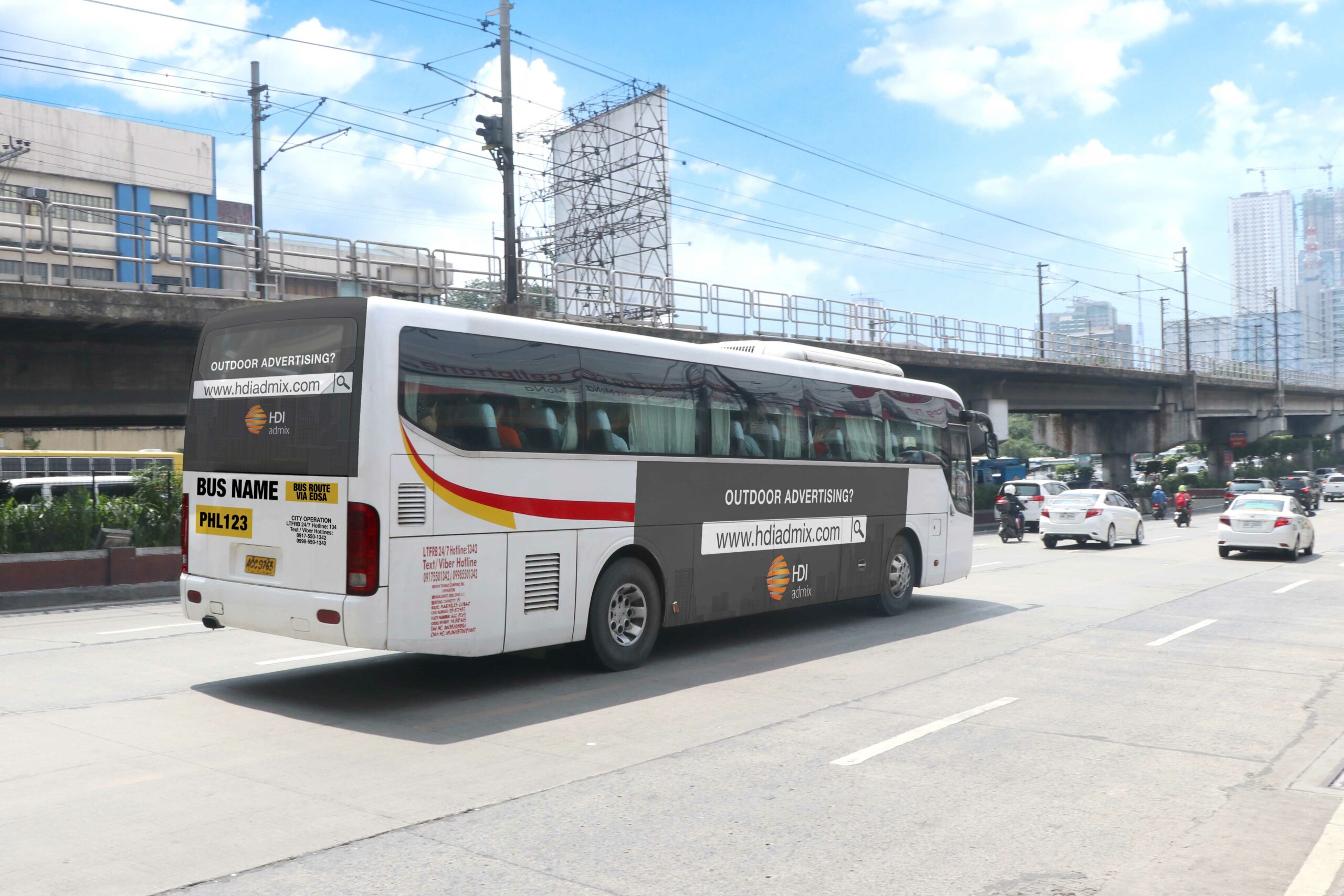Budget-friendly Transit Advertising Philippines for Brand Understanding
Budget-friendly Transit Advertising Philippines for Brand Understanding
Blog Article
A Comprehensive Assessment of the Methods and Strategies for Effective Transportation Marketing Campaigns
Transportation ad campaign provide an unique chance for brand names to engage with diverse audiences in dynamic settings. To accomplish success, it is vital to recognize the subtleties of target demographics, implement ingenious layout methods, and pick optimal positioning areas. Furthermore, the efficiency of these projects can be substantially boosted by closely keeping an eye on performance metrics and adjusting tactics accordingly. As we check out these critical components, it becomes clear that the course to an impactful transportation advertising and marketing approach is both gratifying and complex, increasing the question of just how ideal to browse these complexities for maximum brand name exposure.
Comprehending Target Demographics
Understanding target demographics is crucial for the success of transit advertising projects (Transit Advertising Philippines). Determining details audience sections enables advertisers to tailor their messages properly, ensuring that the content reverberates with the designated visitors. This approach enhances involvement and makes best use of return on financial investment
To successfully analyze target demographics, marketing experts need to take into consideration several crucial factors, including age, earnings line of work, way of living, and level preferences. For example, a project targeted at young experts might focus on convenience and modernity, while one targeting households may stress security and reliability. In addition, geographic factors such as country versus city setups can considerably affect customer actions and choices.
Information collection approaches such as surveys, focus teams, and social media analytics provide valuable insights right into group fads and consumer routines. By leveraging this info, advertisers can craft compelling stories that align with the values and requirements of their target market.
Inevitably, understanding target demographics not just informs the calculated direction of transit ad campaign yet additionally makes sure that sources are assigned successfully. This targeted method enhances the likelihood of attaining campaign purposes, fostering brand commitment, and driving conversions.
Imaginative Style Techniques
Reliable interaction with target demographics relies greatly on ingenious creative layout methods en route marketing campaign. To properly record attention in a congested visual setting, designers should focus on quality and aesthetic impact. Making use of strong colors and high-contrast aspects can boost exposure, ensuring that messages are conveniently clear from a range.
Incorporating vibrant images that resonates with the target market is critical. Aesthetic narration strategies can evoke feelings and create memorable associations with the brand name. In addition, critical use typography assists convey essential details swiftly; understandable fonts and suitable sizes further improve readability.
Including interactive elements, such as QR codes or enhanced reality functions, can involve commuters beyond easy observation (Transit Advertising Philippines). These methods not just promote user interaction however likewise connect the void between conventional advertising and marketing and digital engagement
Furthermore, making use of room artistically-- whether on bus covers, transportation shelters, or metro advertisements-- can bring about cutting-edge layouts that break the mold of conventional advertising. By embracing creative imagination while maintaining brand uniformity, projects can foster a solid link with their audience, eventually driving both awareness and activity. The combination of these design methods is paramount for achieving successful transit advertising and marketing end results.
Strategic Placement Approaches
Optimizing the influence of transit marketing pivots on calculated placement methods that guarantee optimal presence and involvement. Reliable placement involves assessing high-traffic locations and understanding guest demographics to recognize the most useful places for advertisement screens. For instance, positioning advertisements near entries and departures of transportation cars can capture the interest of boarding and alighting guests, thus boosting direct exposure.
In addition, making use of both outside and indoor surfaces of transit lorries can substantially widen reach. Exterior ads, noticeable throughout commutes, engage pedestrians and other vehicle drivers, while interior advertisements target guests in a captive atmosphere. In addition, placing promotions en route centers, such as bus terminals or train terminals, permits boosted impressions as commuters change in between different settings of transportation.
Timing is also essential; aligning the project launch with peak travel periods optimizes target market engagement - Transit Advertising Philippines. Moreover, leveraging digital screens en route settings can promote dynamic material, supplying real-time updates and boosting user interaction. By utilizing these calculated positioning techniques, marketing professionals can make certain that their transportation marketing campaign accomplish optimal exposure, resonate with the target audience, and inevitably drive about his wanted end results

Measuring Project Efficiency
To examine the success of transit marketing campaign, it is important to use a range of measurement strategies that give understandings into audience engagement and general effectiveness. One primary method is using key performance signs (KPIs), such as reach, impressions, and engagement prices, which evaluate how numerous individuals engaged and saw the ad with it.
Studies and emphasis groups can additionally contribute in gauging consumer understandings and recall, allowing marketing experts to recognize the impact of their messaging. Furthermore, tracking site web traffic and social media interaction throughout and after the project helps gauge straight actions to the advertising.
An additional efficient method is making use of location-based analytics, which can supply information walking traffic around particular transportation areas, offering understandings into whether the project successfully captured the focus of commuters. Furthermore, assessing sales data can disclose correlations in between transportation advertising and enhanced revenue, supplying tangible evidence of a campaign's effectiveness.
Study of Success
Understanding the performance of transit advertising campaigns via measurement strategies lays the foundation for taking a look at real-world instances that illustrate effective end results. By employing geo-targeted digital advertisements and analytics, the brand gauged a 30% increase in sales in regions where the covers were plainly presented, showing the straight effect of transit advertising and marketing.
Another engaging example comes from a regional nonprofit company that launched a project on train platforms to advertise an area event. The company combined vivid visuals with QR codes guiding travelers to a registration page. Post-campaign evaluation exposed a 50% boost in event participation contrasted to the previous year. The usage of direct interaction via modern technology magnified the project's reach and efficiency.

Verdict
In see post recap, effective transportation advertising campaigns demand a detailed method that incorporates an understanding of target demographics, ingenious style strategies, and tactical positioning. By prioritizing emotional involvement via bold visuals and enhancing visibility during height traveling times, brand names can significantly improve their influence. Furthermore, ongoing measurement of project efficiency via essential efficiency signs and consumer responses makes certain continuous enhancement. Jointly, these strategies foster brand name existence and make best use of the roi in transit advertising initiatives.
Comprehending target demographics is critical for the success of transit advertising and marketing projects.Efficient interaction with target demographics counts heavily on cutting-edge creative layout methods in transportation advertising and marketing projects. By using these calculated positioning techniques, marketing professionals can guarantee that their transit advertising and marketing projects accomplish right here optimal presence, reverberate with the target audience, and ultimately drive wanted results.
Recognizing the performance of transportation advertising and marketing campaigns through dimension techniques lays the foundation for taking a look at real-world instances that illustrate successful outcomes.In summary, effective transit advertising campaigns demand a comprehensive method that integrates an understanding of target demographics, cutting-edge layout strategies, and critical placement.
Report this page